We may receive a commission when you use our affiliate links. However, this does not impact our recommendations.
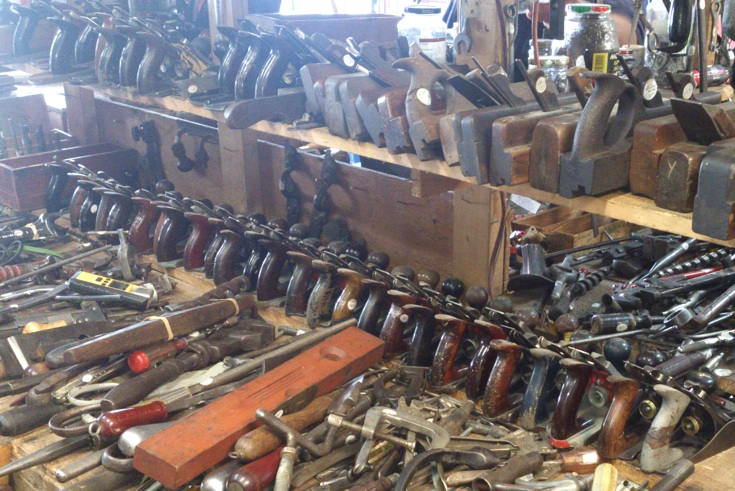
My hand plane quest took me to Liberty Tools in Liberty, Maine. This place was off the cellular network, which obviated the possibility of calling an expert or searching the web.
Brain surgeons have a different method, thankfully, but I’m into simple things so I learn by doing, reading, doing a little more – and eventually throwing myself into the task entirely. Doing always comes first. Still, I wish I’d had this blog post – or something like it – with me yesterday when I went to look for a hand plane to restore.
The object of my search was a pre-WWII Stanley hand plane, made in America and about a #4. I thought I had a pretty good idea of the defining features. What I came away with was a different sort of hand plane, as it appears. I think I got a 1960s-era Stanley “Bailey” hand plane, certainly made in England. It may or may not be possible to tune up well. I only figured this out after arriving home and diving into some internet research.
Here are the clues I have, for your consideration. Let me just say up-front that – lest anyone try to sell me their own unwanted tools in the comments section – I spent nearly three hours at one store, inspecting everything carefully. It’s more confusing than I had anticipated. The overall heft and appearance of this tool made me think it was “old enough.”
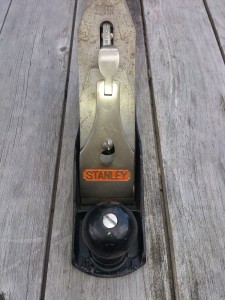 1. A cheap, plastic front knob and, on the lever cap, a kidney-shaped screw hole. My excuse? I saw a wooden tote on the back and assumed the front knob was an after-market replacement. This led me to the further assumption that the lever cap and, as you’ll see later, the frog were also replacements – which didn’t seem too big of a problem. I was looking for a work plane rather than a show plane.
1. A cheap, plastic front knob and, on the lever cap, a kidney-shaped screw hole. My excuse? I saw a wooden tote on the back and assumed the front knob was an after-market replacement. This led me to the further assumption that the lever cap and, as you’ll see later, the frog were also replacements – which didn’t seem too big of a problem. I was looking for a work plane rather than a show plane.
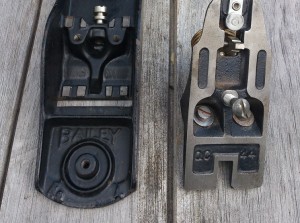 2. I went to the screwdriver section of this well-stocked store and removed the front knob and the frog. This was the cleanest plane I’d seen so far. Being an optimist, the words that came to mind were “well cared for,” rather than “relatively new.” I did not know the significance of the raised ring surrounding the front knob, nor the lack of patent numbers behind the frog base. Apparently, this plane was screaming “1960s” at me but I wasn’t hearing it.
2. I went to the screwdriver section of this well-stocked store and removed the front knob and the frog. This was the cleanest plane I’d seen so far. Being an optimist, the words that came to mind were “well cared for,” rather than “relatively new.” I did not know the significance of the raised ring surrounding the front knob, nor the lack of patent numbers behind the frog base. Apparently, this plane was screaming “1960s” at me but I wasn’t hearing it.
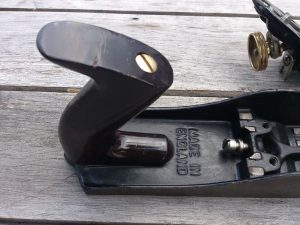 3. This was curious, as they say in England. There was an obvious stamp below the tote that read, “Made in England.” I remembered seeing something online that said the British-made Stanley planes were a bit heftier than the American ones, and indeed it felt more substantial than the others I was lifting and inspecting. I decided I liked how it felt, and since everything else was looking pretty good … why not go British?
3. This was curious, as they say in England. There was an obvious stamp below the tote that read, “Made in England.” I remembered seeing something online that said the British-made Stanley planes were a bit heftier than the American ones, and indeed it felt more substantial than the others I was lifting and inspecting. I decided I liked how it felt, and since everything else was looking pretty good … why not go British?
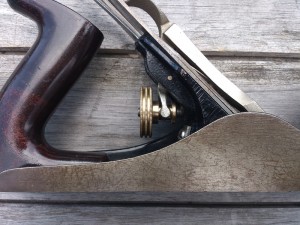 4. Click on the image at left for a bigger version, and you’ll see what kept me up last night – the fork, as I think it’s called, straddling the adjustment nut. It is pressed steel. I only noticed this after I returned home and started surfing the web. But you can also see from this side view that everything else is looking pretty good. The body needs a good clean-up and sanding. Other than that, I thought I was looking at a functional, ready-to-go hand plane.
4. Click on the image at left for a bigger version, and you’ll see what kept me up last night – the fork, as I think it’s called, straddling the adjustment nut. It is pressed steel. I only noticed this after I returned home and started surfing the web. But you can also see from this side view that everything else is looking pretty good. The body needs a good clean-up and sanding. Other than that, I thought I was looking at a functional, ready-to-go hand plane.
It seems to me that those who buy new or slightly used Lie-Nielsen hand planes, for an additional $200 or so above what I paid for my vintage Stanley, have a very strong argument. I’m looking forward to the day when I have an extra $200 for that. For now, I’m stuck with my little British baby, and I figure I’ll make the most of it. We have a heap of great sharpening and tuning resources here at Popular Woodworking. I’m starting with those, and you should, too, if you’re interested in this type of work! Click here to check out our value pack of the month on sharpening and tuning. Buy it and follow along with me over the next few weeks.
It isn’t brain surgery, after all.
–Dan Farnbach
Here are some supplies and tools we find essential in our everyday work around the shop. We may receive a commission from sales referred by our links; however, we have carefully selected these products for their usefulness and quality.







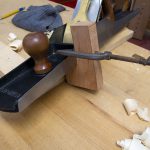
This is an interesting post. I happened upon your post due to the picture of all the planes. I was just at this place 2 weeks ago. I live in Ellsworth, Maine which is about 30 mins away from Bar Harbor. It took me many years to make it over to Liberty. The reason I wasn’t in a rush to visit there is because the sister location called “The Tool Barn” is right in Bar Harbor and is more hand tool oriented, hard to believe I know. But this is a weekly visiting place for myself and I come out of there with at least one tool every visit. It is just stammering at how jam packed The Tool Barn is and is the reason I am a hand tool oriented woodworker. I consider myself very lucky to have this place right down the road from me. Skip is the owner’s name and he has also written a few books on tool makers of the past. He’s a different dude but certainly has paved the way in keeping such tools alive. He might even have an online website. If you search Davistown Museum in Bar Harbor or something like The TOol Barn you might come up with something.
Many thanks for adding the blog to “favorites,” and keep the comments coming. The feedback and information is helpful to everyone who visits here!
RE: midwestern stores … I do not know but will ask during our meeting today with the Cincinnati crew. What I do know is that, as Chris Schwarz says, they could practically “pave the streets” with vintage Stanleys of all varieties here in New England.
I’m biased, but to answer your questions about where to find more information … I really like Chris’ articles and videos. I dig through everything on the internet, but I think Popular Woodworking takes a very sensible approach to this question. Sort of a “do what works” approach.
Thanks for your experience. I live about 200 miles west of Cincy on the Ohio. No tool stores like that within miles or maybe states. Soooo…to eBay I go. I have purchased Stanleys from No. 2-8. I watch constantly and feel good that it is not often I see prices lower than what I paid. I look for “keyhole” as much as possible rather than “kidney”. I have now told you about all I know about the Stanleys. My No. 4 came from my father-in-law who got it from his dad in the early 1900s. So I think it is good and most likely all original.
Two questions, Do you know of any “midwestern” stores like Liberty and if so where? Flea markets just aren’t working well for me.
What are your sources for information about Stanley planes? I try to read up but want to expand my source list.
Thanks for the sharing.
My first time on this blog and am impressed. I have a #5 with parts from 3 manufactures. Purist out there are fainting but it works like the vintage Stanleys I have. IE what’s important is what you do, not who/where it was made. Patricks “Blood and Gore” is the best Stanley info out there. Chris S book on tuning planes should be on everyone’s shelf.
‘S-cuss me but I have go put this site on favorites.
Hi Dan, As a shop teacher for 30 years I found purchasing used Stanley planes and tuning them up was the way to go to supply my students with good tools. Now as a vintage tool dealer I am supplying many woodworkers with fine vintage tools in ready to use condition. On my website takeadiptools.com I have written articles on restoring vintage tools to assist woodworkers. (A good start for this plane.) Selling on eBay for 15 years with 100% positive feedback and 100% return policy. (Yet no one has ever returned a tool.) Yet as many bash eBay woodworkers are highly satisfied with the quality of tools they receive from me. What I am suggesting is if you want something specific and top quality contact me. I am president of the NJ antique tool club CRAFTS and would like to see every woodworker be happy with a tool they purchase. Best vintage plane in my opinion is a 1930’s vintage with every important patent improvement on the plane still with a solid frog to iron mating surface. It has the kidney shape hole for tight locking of the lever cap. It has the tall rosewood knob and lg. brass adjuster for cutter. These are top quality planes made for the professional and tune up to be great planes. Yet you have this English plane and I think if you put some time into tuning it up you will get good results with its use. Best Regards
No, it’s not the ideal vintage. Yes, there are differences in the iron and manufacture. Yes, it’s harder to adjust than a bedrock. On the other hand, you should still have a perfectly adequate plane with a little work. it’s the same basic design, and it’s hardly junk. Try it, you’ll probably grow to like it.
Dan – are you sure that fork is pressed steel? Blowing up the picture shows it as a forging to me – like stirrup.
Kind regards – John
After you use this for a while……..and especially when you find an older one and use them side by side?
you will find out.
Its not the weight or the trim or even the machining that makes the difference.
Its the basic iron itself.
The reason the early planes really are better is the iron.
In later days practically anything that would melt and fill a mold could be called a tool. Certainly now, hardly anyone even remembers that is does make a difference.
But in earlier times, people knew what made an iron tool. Competition was stiff and it better be fine grained stable iron! They were careful about what they put in the batch, they took the extra trouble and expense to properly anneal it and then they seasoned it. There was a much higher rejection rate since they were a lot more picky about the finished goods.
The early tools had a lot more mach8iing as well. Bedrock has the big reputation but the earlier planes had almost as much machining and ever better iron.
Its the basic element that matters more then anything.
Don’t take my word for it. Investigate for yourself
Oh the other thing that is clearly better is the wood. Suppose its 1880 and you are buying wood, what are you going to pick?
OK, now its 20 years later and that’s gone, what next?
OK now its 100 years later, now what wood can you get?
You see what I mean.
yours Scott
Hmmm,
Well, I’ve had a bunch of tools for years that may or may not be the best in vintage tools. But you know, I didn’t;t know they weren’t vintage until the internet told me they weren’t!
Good thing the wood doesn’t read the internet…
Albert A Rasch
Oh PS: Yeah I’m liking your blog Dan. Lots of variety, good questions on your part allowing everyone to contribute,. Keep it up! AAR
Dan, you’re embarking on a great adventure! As the old Nissan ad says: Enjoy the Ride.
All the above suggestions square with my (limited) experience. I would suggest that rather than shopping eBay or the like for Hock blades, you contact them directly at the phone # on their website. Utterly delightful people, deeply knowledgeable and very helpful. The replacement blates from Lee Valley/Veritas aren’t quite as thick (and chatter-free) as the Hock blades but more closely match the shape of the original. The square shoulders on the Hock blades are easy to like once you see the results the blades produce; as an added benefit, the Hock Tools email newsletter is always interesting. I find I prefer the O1 blades in my own tools, but mostly for reasons of habit rather than logic.
Remember, you’re doing this to enjoy it; it’s your plane and you don’t have to answer to anyone about what you do with it.
Best regards,
Mike Roca
It seems the best tools can only be found when you travel off the grid. A little prep work can save you though. You can make portions of web sites available offline on andriod and chrome with the My Klips ap. found here
https://chrome.google.com/webstore/detail/my-klips-read-now-read-la/hkpekaddkiibmnedmbgbpfmegmpfmbai.
So on a day you are going to look for planes you can sync up a number of websites so you can guarantee you will be able to look them up anywhere as long as your batteries hold out.
Happy tool hunting,
Brent
Hi,
The orange around the Stanley logo is a sure sign of a ’60’s or ’70’s plane, but it’s still a solid chunk of metal. It will work great. As a #4 it’s a smoother, so you need to really sharpen the blade and tighten up the mouth. A Hock or other aftermarket blade wouldn’t hurt, but it’s a fun weekend (Fire! Fire! hehehehe) making an iron from scratch out of O-1 tool steel.
Or you could just cant the blade, have a really light jack plane and save your money for a 604 or LN #4.
jasper13, dwfree and Window Guy – amazing links and tips! Thanks from me personally, but also on behalf of the broader community who I’m sure will benefit from finding these comments.
Hi Dan,
Been there done that, but like you I like to learn as I do and go. I like to read so I do what research I can, get the tool or whatever and take it apart to see what makes it tick. I think I can fettle pretty well now and really enjoy it, but one thing for sure make sure the blade is as sharp as you can get it, sharpness is critical.
The main reason for the response is since you are diving into Hand Tools some what ( good choice BTW ) there is a forum that maybe you have heard of or not. It is called Woodnet.net ( http://www.woodnet.net ) I have learned a great deal and met some really nice folks who know what they are doing and talking about as well. Also there is a S & S column ( Swap and Sell ) where there are a lot of folks who sell nice quality tools, Admiral, Steve F., Josh Clark ( hyberkitten), Walt Q. ( Brass City Records and Tools, Patrick Leach to name a few. Just thought I would pass this along and truthfully this is where I buy most of my tools and haven’t been disappointed yet.
You may want to speak with with Megan, Bob, and Chuck and of course Chris S. they chime in there once in a while about this web site and forum.
Good Luck with your hunt and search !
Steve
BTW: I enjoy your column.
Don’t fret over the vintage of the plane. I have a couple of these and they work as well as the older vintage I have, they just don’t have the $ value of the older ones. Frog position changes on any but bedrocks are a pain. Flatten the sole & frog, de-burr all machined edges (stones, files, sandpaper), learn how to truly sharpen the blade (I use 3M polishing film & jigs – freehand is quicker but doesn’t get as sharp or hold an edge as long), dress up the chip breaker (50°-60° angle – Schwarz has an article on this), and it will work well. Stock blades work well when properly sharpened, although the thicker blades/breakers hold an edge longer and chatter less with a dulling edge. Sand off the molding lines on the front plastic knob and it will work fine. The amount of time and accuracy needed for fine tuning depends on how you use the plane. If you want a fine finish smoother, more time and attention is required. My Bailey’s and Bedrocks can’t match the performance of my Veritas planes, but I enjoyed the journey and continue to enjoy using them.
Dan,
I’m enjoying the articles. I joined the Kansas City Woodworkers Club and am amazed at the wealth of information these members are just dying to share. Anyway, I think you are on the right track with your plane project. Restore it, and learn to use it. That’s what I’ve done and enjoyed it. Ebay is a good source for affordable Hock blades which I installed. Anyway, when my skills exceed the quality of this tool, I’ll look to restore a bed rock and sell this one. After all, you have to think about the guy who walked into the store, bought your plane new and used it because that’s the best they had back then.
A few years ago I started a policy that’s been helping me a lot:
don’t look up the tools you want to use on the internet until you’ve tried to make them work.
Too many times I’ve come home with a new find and felt the disappointment of discovering it’s not the perfect vintage. Too many times I’ve neglected to give that tool enough of a chance.
Years later, as my confidence about tuning tools has grown, my concern for knowing whether someone else thinks a tool is good has disappeared.
Don’t lose sleep over that fork. It looks like a casting to me. But anyway, who cares, the plane feels good to you right? It’s going to feel amazing when it’s whipping out shavings.
One of my favorite parts of this post was knowing immdediately, without reading the caption, that this was Liberty Tools. I have stood in that exact same spot many times. I love my Lie-Neilson I can’t afford everything right now. I buy my planes and “practice” tools at Liberty Tool. I add L-N blades to meet in the middle of quality and affordability. For those who have never been to Liberty Tool. The picture is just a small example of the tool mayhem it embodies. Thanks for your post. I appreciate reading and learning from people in a similar situation to me.
Chris’ DVD on restoring a handplane helped me significantly in deciding how to restore my great-grandfathers #4. You may have found Patrick’s blood and gore online – it has boatloads of info on Stanley planes.
Also, does anyone have an idea where I can find a similar “store” in central Ohio?
Do you mind sharing where the store was located?
Dan, still looking forward to when you tell us how you overcome the limited space in your flat with regards to setting up a work area 🙂
Adjusting the frog may take a little effort, that’s why the bedrock design is so good, but a flat sole and a good new blade, like a $40 Hock, and you’ll be just fine. Enjoy